Outwoods Reservoir (2017)
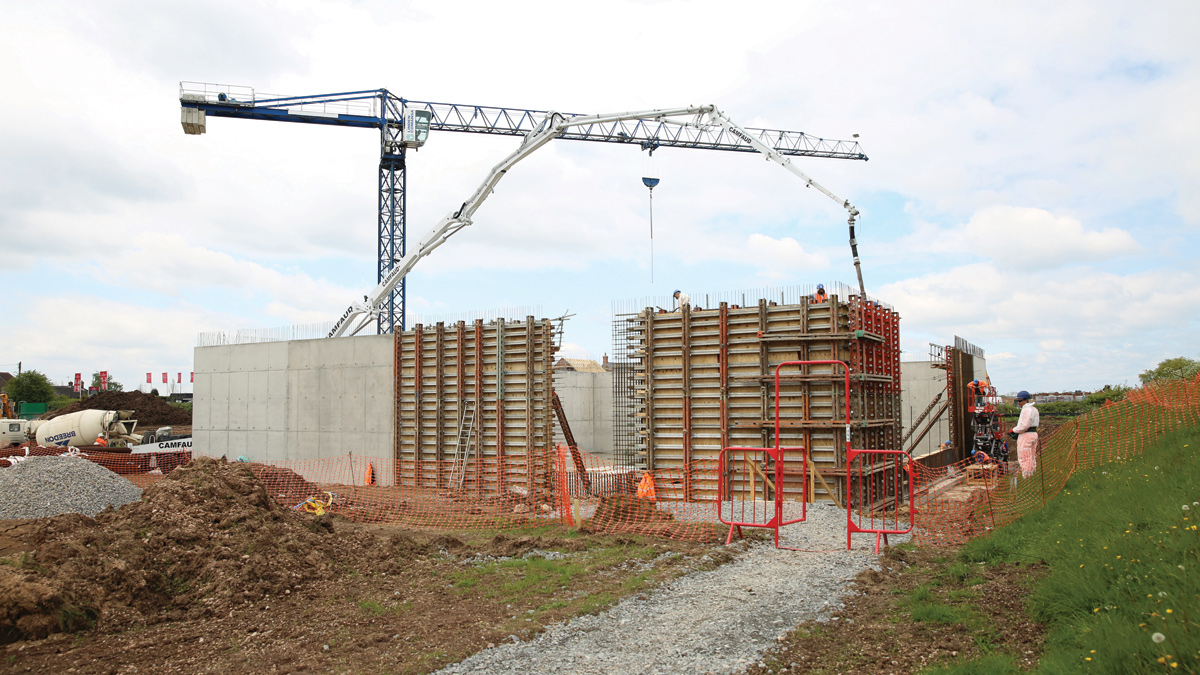
Concrete pump being used to pour the wall sections of reservoir 3 - Courtesy of Stonbury.
The original Outwoods Reservoir (No.1) was constructed in 1882 in Burton on Trent. An additional Reservoir (No.2) was added in 1962 in response to increased demand on supply. In 2017, South Staffs Water awarded Stonbury the contract to replace Reservoir No.1 which has proven increasingly expensive to update and maintain and was taken out of service in 2016. Water is taken by South Staffs Water from the Blithfield Reservoir (near Lichfield) and pumped to the nearby Seedy Mill Treatment Works. Once cleaned and treated it is then pumped into the network which includes the storage reservoirs at Outwoods. The water is then released from the storage reservoirs into the local supply as needed. The Outwoods supply zone, fed from a number of storage reservoirs at Outwoods in Burton Upon Trent, includes approximately 26,000 properties in Burton upon Trent, Rolleston on Dove, Barton under Needwood, Alrewas, Fradley, and Streethay, with a combined total average daily demand of 23 million litres. The project was challenging with a tight programme and proximity of protected species but achieving the deadline meant ensuring the supply network can continue to operate to provide a safe and reliable water supply for current and future generations.
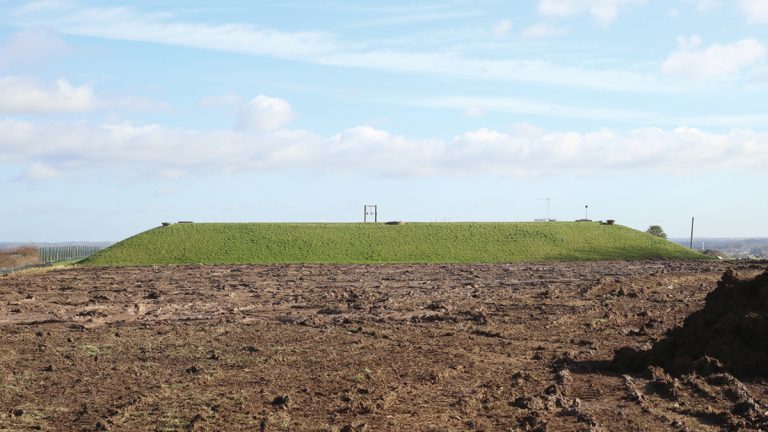
Day 1 on site after the Ecologist had completed their work – Courtesy of Stonbur
Background
South Staffs had originally been awarded planning permission for a new reservoir on the footprint of Reservoir No. 1 in 2014. The project was delayed due to unexpected work on other schemes within the South Staffs Water supply network. Whilst the site was still able to function it was important that both storage capacity and resilience of the site were increased.
The decision was made to locate the new reservoir on a greenfield area of the site rather than in the footprint of Reservoir 1 to reduce the overall construction programme and meet supply demand. This would not only enable South Staffs to operate two reservoirs at all times, but also opened up the opportunity to build an additional reservoir in the future on the footprint of Reservoir No1. This investment will help to guarantee the quality and reliability of the local water supply for the next 100 years, and play a key part in meeting growing demand from new housing being built in the area.
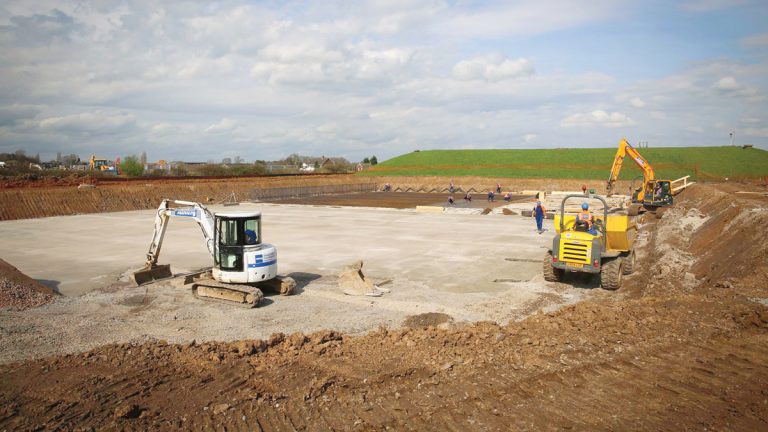
Excavation and blinding of the base of reservoir 3 and 4 – Courtesy of Stonbury
The contract
Stonbury has worked closely with South Staffs Water for many years and currently holds a five-year Framework with them for Reservoir Refurbishment. Nationally, the company typically refurbishes and repairs around 450 service reservoirs each year; this, however, is the first time that Stonbury has been made responsible for a new-build reservoir.
The tender process involved a high level of optioneering of all possible solutions, including temporary tanks, steel tanks and GRP tanks. The option selected was a hybrid solution for a reinforced concrete structure, which included precast concrete columns and roof structure. This was deemed to be the most cost-effective solution in respect of both whole life costs and design life, as well as one capable of being delivered to the very challenging programme.
Stonbury subsequently completed the detailed design stage, which developed the outline design, submitted at tender stage. It was decided to split the reservoir into 2 (No.) 5Ml tanks to speed construction and enable delivery of one of those tanks into service at the earliest opportunity and further increasing long term storage resilience.
From the date that Stonbury gained access to the site on the 9 March 2017, there was a 16-week timeline specified by South Staffs before commissioning the first reservoir by 1 July 2017.
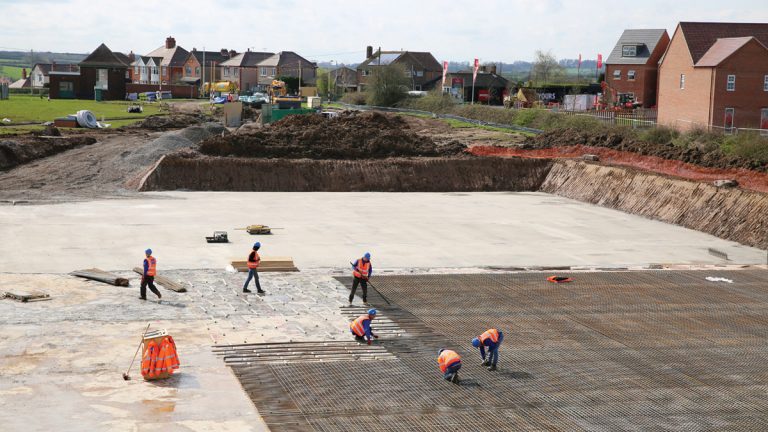
Reinforcement being installed for base slab of reservoir 3 – Courtesy of Stonbury
Ecology evaluation
Shortly before work was due to begin, an ecology evaluation highlighted the presence of Great Crested Newts (GCN) on a housing development adjacent to the site. As a European protected species, these animals, their eggs, breeding sites and resting places are safeguarded by law.
Following a full ecological survey an environmental specialist and licensed ecologists were brought to site to work alongside Stonbury to prepare the site for construction in the shortest possible timescale.
Whilst no GCN or nests were physically found on site the erection of reptile barrier fencing and hibernaculum ensured the protection of GCN during and beyond construction.
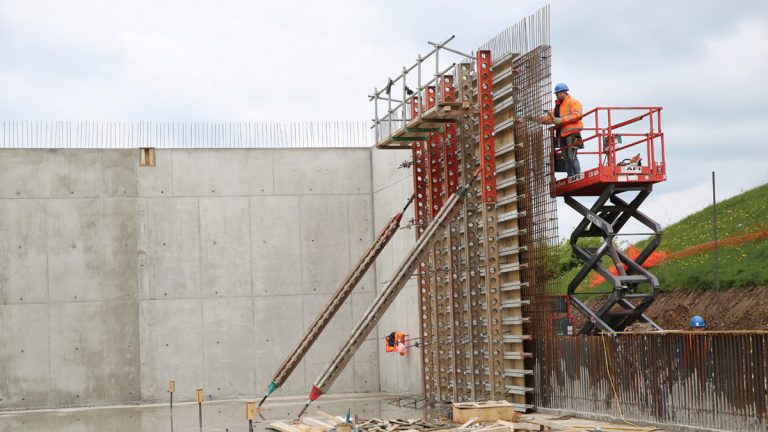
Formwork being erected for a concrete pour on the walls of reservoir 3 – Courtesy of Stonbury
Coping with the delay
The steps taken to protect the Great Crested Newts did, however, have a severe knock-on effect on the work schedule. A full eight days were lost on the commencement of excavation work.
An additional element was also added to the original specification: the construction of a concrete valve chamber to house all the pipework coming into and out of the reservoir. This was to be a 12.8m long by 6.8m wide by 4.85m high structure.
These delays, as well as heavy rain severely affecting progress on several days, presented Stonbury with the main challenge of the project. South Staffs Water agreed to adjust the budget to allow for 12-hour day and weekend working by the team, with some personnel then on duty every weekend. The team of people assigned included up to 25 operatives at any one point.
Whilst the team were able to work the additional hours to bring the project in on time, accelerating the schedule meant that problems arose with the timely delivery of key materials.
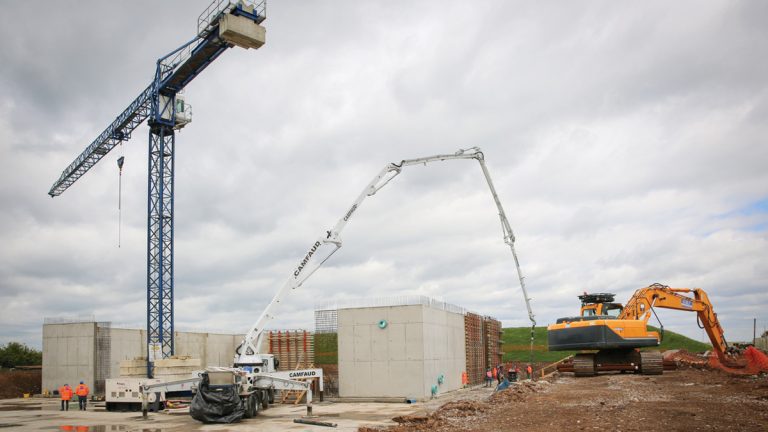
Concrete pump in position to pour concrete to wall slab of reservoir 3 – Courtesy of Stonbury
Commissioning
The original date set for commissioning the reservoir on 1 July 2017 was met, and the first stage was to fill it for its seven-day testing.
The final inspection was conducted by the client and the project deemed completed and handed over. The reservoir was then dropped, re-cleaned, filled and sampled for return to service the week commencing 10 July, just 17 weeks from breaking ground.
Community engagement
Ahead of work beginning on site, Stonbury and South Staffs embarked on a community engagement programme with local residents. The reservoir is close to housing, and concerns had been expressed during the planning process that lorries entering and leaving the site would have a negative impact on local roads which serve a primary school and children’s nursery, and which regularly experience congestion at peak times.
South Staffs Water pro-actively engaged with the local residents and the nearby primary school leading up to construction to ensure everyone was informed and given the opportunity to raise concerns. The project delivery team also set up a community portal system, enabling members of the public to follow progress of the scheme and to communicate directly with the delivery team, express concerns and ask questions.
Keeping local communities informed through a community portal has proved beneficial; especially larger schemes close to housing. As well as providing a level of transparency that can defuse potentially contentious situations, it gave Stonbury the chance to keep local people informed of changes to schedules, and to take on board constructive suggestions informed by local knowledge that will help us do a better job.
Feedback on the portal led directly to changes being made during the works programme. Early in the project, for instance, concerns were expressed about the number of lorries making deliveries to the site at peak times. As a direct consequence, the timings were changed to spread lorry journeys through the day.
Stonbury were also able to reassure locals that the final appearance of the reservoir would enhance rather than detract from the appearance of the site. Half of the reservoir is buried, so no views have been detrimentally affected and Stonbury committed to creating a natural looking, grass-covered mound using all of the top soil excavated.
Outwoods Service Reservoir: Key facts
- 10Ml storage requirement.
- Chamber size: 27.5m x 34m x 6.1m high internal measurements x 2 cells.
- Overall programme of 28 weeks, including all site works.
- Over 300 tonnes of reinforcement steel used in construction.
- Over 2,500 tonnes of concrete utilised.
- Over 15,000 tonnes of spoil removed.
- Spoil reused on site for landscaping: 100%.
- Client: South Staffs Water.
- Contractor: Stonbury.
- Out-turn cost: : < £2.5m.
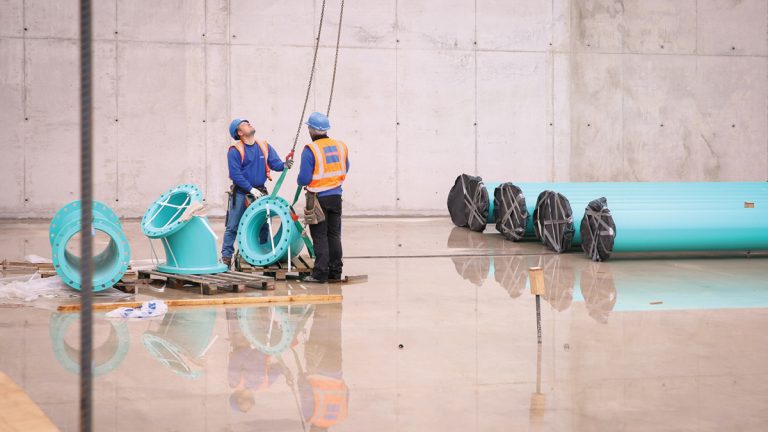
Installing Scotchkoted 500mm pipework inside the reservoir – Courtesy of Stonbury
Community engagement in action
As well as providing information, the community portal allowed a free flow of questions and answers between the project team and local residents as this exchange shows:
Gemma (local resident) – 20 March 2017: Can you explain how the trial holes are done please?
Barry Chapman (Project Manager) – 20 March 2017: Hi Gemma – Thanks for showing an interest and that is a very good question.
The location of the mains are known but we don’t know the depth. We have to get an accurate depth of the main to ensure there is no conflict with the new pipework that will be connecting into the new reservoir. It also helps the designer to detail the pipe fittings required to connect the pipework at different levels.
We estimate the depth of the main to be 4m. There will be three trial holes excavated at different locations on the site. A 14-tonne excavator will be used to dig the holes. As the holes are so deep, a metal box (called a trench box) will be lowered into the ground as excavation proceeds. Once the main has been located, an engineer will plot its location and depth. The hole will then be filled with the excavated material and compacted. The trench box will be removed as filling proceeds. Once this is complete, the second trial hole will be excavated in the same manner. Let me know if you have any other questions.
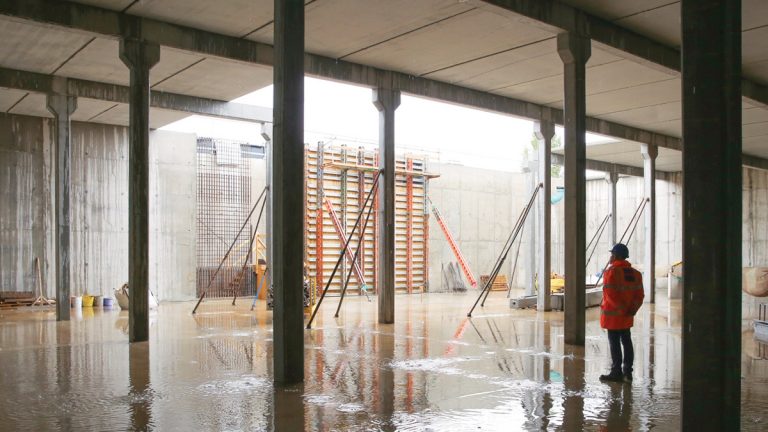
Concrete support columns and roof planks installed in reservoir 4 – Courtesy of Stonbury
Conclusion
Projects like this always present challenges but the combination of unavoidable delays and tight deadlines always create extra problems. Many of the UK’s service reservoirs are now coming up to their ‘sell-by’ date, and while refurbishment will always be the preferred option where technically feasible, replacement will often offer an economical, long-term solution for clients looking to protect their assets and ensure continuity of supply into the future.



